This is a basic training plan developed in honor of St. Joseph who was chosen by God to be a Provider, Protector and Leader of the Holy Family. The plan works on developing both spiritual and physical strength so you may worship God with all your soul and strength.
"Hear, O Israel:
The Lord our God, the Lord is one;
and you shall love the Lord your God with all your Heart,
and with all your soul, and with your entire mind,
and with all your strength."
Joseph the Warrior
Nevertheless, Christian men are called to be meek and humble. “Far from being weak, however, the meek possess an inner strength to restrain anger and discouragement in the midst of adversity” (Ignatius Catholic Study Bible). We can practice these ideals in the simple ways in which we respond to the challenges of everyday life. Whether our wives snap at us at the end of a long and frustrating day, or a guy rudely cuts us off on the freeway, our responses define us. It is inevitable that life will provide us with major adversities in which to practice these difficult virtues! How you respond to God’s grace can truly make or break these experiences. We are called to be charitable, to love others and even pray for our enemies. It takes heroic strength and defining virtue!
Courage is also needed in order to withstand the storms of life that come our way. I can’t help but call to mind one of my favorite speeches from the classic movie, The Count of Monte Cristo:
Life is a storm my young friend, you will bask in the sunlight one moment, be shattered on the rocks the next. What makes you a man is what you do when that storm comes. You must look into the storm as you shout as you did in Rome. Do your worst for I will do mine. Then the Fates will know you as we know you as Albert Mondego, the man.
There is something compelling in a man that seems to be calling us to fight and compete; but where is our ultimate battle? With whom are we fighting?
Joseph is our ultimate example of what it means to live authentic masculine Christianity. He was quite possibly the meekest and most humble of all. Yet at the same time, he was without question a warrior and a fighter. He participated in the greatest battle of all time. However, it was precisely his humility and meekness that allowed him to trample over the Evil One rather than faltering before him.
St. John Paul II proclaimed, “The family is placed at the heart of the great struggle between good and evil, between life and death, between love and all that is opposed to love” (Letter to Families, #23). Pope John Paul II insists that at the core and heart of Satan’s attack is the family. We see this vividly played out in the book of Revelation. “And the dragon stood before the woman who was about to bear a child, that he might devour her child when she brought it forth; she brought forth a male child, one who is to rule all the nations with a rod of iron, but her child was caught up to God and to his throne” (Rev 12:4-5).
The Church understands this passage to have multiple meanings, but it is particularly clear that evil is attacking Our Lady and the Christ-child. This verse strikingly illustrates the attack of Satan at the very heart of the family. This is both a spiritual and a practical truth.
God chose Joseph for this battle because Joseph was a warrior for God. When Joseph said “Yes” to take Mary as his bride and Jesus as his Son, he was avowing “Yes” to engage in the most epic battle in human history. He was prepared to fight to the end to keep his family safe. From the beginning of Christ’s life, the powers of darkness wanted Joseph’s child dead and were willing to go to extreme lengths to accomplish their ambition. It’s incredibly ironic that Herod needed to take the life of an infant, the weakest and most helpless of mankind, in order for him to remain in a position of absolute power and strength. Herod represents an icon of what men who desire power over humility are willing to do and what men of humility are up against.
On the other hand, Joseph was willing to do whatever the Lord asked of him no matter what the personal cost. What strength! Most men lack the strength because most men lack the meekness.
Mondays Plan
- pray every two hours (check your posture and breathing) consider asking assistance of the nine choirs of angels. Remember St. Joseph always revered and followed the instructions of the angels.
- Today's exercise honors St. Joseph as provider in his work it is most likely he needed to fell trees and drag it to his shop. Today's workout honors St. Joseph as a lumberjack.
- Start the day ss St. Joseph did with the Shema and a big lumberjack breakfast. (If you want to mirror St. Joe skip the pork.)
- After eating walk for at least an hour (to the logging site) after training walk back home. More than likely during these walking times this was St. Joe's prayer time.
- Stretch for 5 minutes before strength training.
- Lumberjack training
- Mobility and Endurance
- Weighted Squats: 3 sets x 8–12 reps
- Box Jumps: 2 minutes with as many reps as possible
- Kettlebell Clean and Squat: 2 minutes with as many reps as possible
- Core
- Cable Rotational Chops: 3 sets x 8–12 reps
- Planks: 5 sets x 30 seconds
- Pull-ups or Chin-ups: 2 minutes with as many reps as possible
- legs, glutes, core and arms
- Kettlebell Massive Swings: 2 minutes or 24 reps
- Farmers Carry: 3 sets x 30–50 feet with moderately heavy weight
- Rowing Machine: 5–7 minutes
- 20 minutes jog after.
- Stretch
Tuesdays Plan St. Joseph would have
been instructed in the torah and perhaps the Zohar.[1]
"Yehudah Ben Teima says: Be courageous as the leopard,
light as the eagle,
swift as the deer,
and strong as the lion,
[so that you will be able]
to do the will of your Father in Heaven." Avot 5:20
"Ba'ey Gufa Takif Gibar KaAri" - One needs a body strong as a lion. Zohar 3, 160a, Otzar HaZohar 4, 823b
"Ba'ey Gufa Takif Gibar KaAri" - One needs a body strong as a lion. Zohar 3, 160a, Otzar HaZohar 4, 823b
One of the most
important things that one needs to have in order to properly walk the
path towards God is the health and strength of the physical body.
Throughout the generations the Sages have emphasized the importance of
the Biblical commandment to be physically healthy and strong.
Unfortunately today many people of religion do not properly observe this
most important obligation. In order to
fulfill the Biblical obligation to maintain our health, the performance of
physical exercise should be viewed as a being an essential observance of
religion. Even with proper
eating there cannot be good health without exercise. These are the words of
one of the world's greatest physicians, who just so happened to also be one
of the worlds greatest Sages. I am speaking, of course of RaMBaM
(Maimonides). In his law code, the
Mishneh Torah (Deot 4:14,15) Maimonides
writes that one is to "exercise and exert oneself greatly."
- Pray every 2 hours a different day of the Novena to the Holy Face or do the rosary or spend 20 min. in adoration. Pray for our Pope, Bishops and priests. Pray for our those in authority
Do a Dynamic Stretching Routine[2] while do a
jog; running a minute-stretch-run a minute and stretch; do twice.
Complete 10 reps of each
exercise below for 1 to 2 rounds.
- 1. Lunge with a twist
- As the name implies, this is a combination of two different moves: a forward lunge and a horizontal twist. The forward lunge helps stretch the hip flexors and activates the legs, glutes, and hips, while the twist stretches out the upper and middle back and activates core rotation. As you do the lunge, step forward, then drop your hips. Don’t lunge so far forward that your front knee extends beyond your toes. After you’ve lunged, slowly twist toward the side of your front leg for a more intense hip flexor stretch.
- 2. Knee to chest
- This exercise mimics the top of a running stride as you bring your knee toward your chest before lowering the foot toward the ground. You can alternate each leg while stationary or do it while walking forward. Focus on bringing the knee cap into your chest by hugging your shin while stepping onto your toes with your opposite foot, which will give you more leverage.
- 3. High kicks
- High kicks help warm up the hamstrings and improve range of motion. You can do them, alternating, as you walk. I prefer to do them stationary while focusing on one side at a time. If starting with your right leg, extend your left arm straight out. Kick your leg up while keeping your leg and hand straight so that your toes hit your palm. Try to progressively kick higher, but complete this exercise while staying under control.
- 4. Hip stretch with a twist
- This is an exceptional stretch, especially for working professionals who sit a lot during the day. It helps open up the hips and groin while stretching the core, upper, and middle back. Start in the pushup position and bring your right foot up to your right hand while keeping your hips down and lower back flat. Lift your left hand, twist to your left while extending your arm and reaching toward the sky. Come back to the starting pushup position and repeat on the other side. A substitution for this exercise would be a side lunge to help work on your lateral movement.
- 5. T pushups
- A T pushup is a great exercise to help warm up your upper body, especially the shoulders, while also activating your entire core. Start out in the pushup position, then lower yourself down toward the ground. As you push back up, extend your right arm toward the sky while keeping your left arm stable and your hips from moving down or up. Bring your arm back to the starting position, do another pushup, then repeat with the left arm.
- 6. Jump squats (advanced)
- Jump squats are a great plyometric exercise for warming up the lower body. Because the exercise is fast, it requires a greater degree of force production and power than the other exercises on this list, so it’s a more advanced warm-up exercise. Stand up with your feet about shoulder width apart while holding your hands behind your head, or on your hips. Squat down until the hips are about parallel with the ground, then jump with force. Land softly and repeat the jump.
- 7. Jump lunges (advanced)
- Jump lunges are another great plyometric exercise for warming up the lower body. This exercise also requires balance to activate the stabilizer muscles in your legs and hips. With your hands at your sides or behind your head, start with one foot extended forward and one behind. Drop your hips downward and forcibly jump into the air. While you’re in the air, switch your legs so that your forward leg is now behind you and your back leg is now in front of you.
- Making it easier
- To make this dynamic warm-up easier, you can do some of the exercises assisted while holding onto a sturdy and stable pole or object. For example, you can do an assisted squat, or assisted reverse lunge, which makes both exercises much easier and more manageable. With the hip stretch, you can choose not to open up your shoulders, and with the T pushup, you don’t have to do the whole pushup itself.
- Today's exercises:
- Cardio 5 min warm up before a strength workout
- warmup today will with Posture exercises
FM 20-21: War Department Field Manual, 1946
Posture Training
GENERAL
PRINCIPLES OF POSTURE TRAINING. There is no one “best posture” for all men because the physical architecture of individuals differs according to the bony structure they inherit. Therefore, to develop the best posture for each member of any given group certain general principles must be applied intelligently to the group as a whole as well as to each man. These principles are:a. To teach the characteristics of good posture.
b. To provide an opportunity to “feel” or practice good posture.
c. To have the men practice proper posture until it feels more comfortable than poor posture.
d. To motivate the men to acquire it as a habit.CHARACTERISTICS OF GOOD POSTURE. The first step in posture training is to teach what good posture is. Many men have a misconception as to what constitutes good posture. For example, they arch the lower back, thrust out the chest and retract the shoulders in an exaggerated manner, or they spring their knees backward. The characteristics of good posture are head balanced and erect, chest held high without tension, abdomen flat, shoulders back and relaxed, lower back only slightly curved, and knees straight but not stiff. Instructors should explain and demonstrate the position of the various parts of the body in proper posture.TRAINING FOR GOOD POSTURE. The men must be provided with opportunities to feel and to practice good posture. Many individuals feel more natural while maintaining a bad posture. Certain muscle groups must have special training to maintain good posture without undue fatigue. The exercises below will provide this training. The emphasis upon proper posture must not be confined to physical training periods only. A good military bearing must be insisted upon until the men assume it from habit.MOTIVATING GOOD POSTURE. Regardless of the amount of exercise and instruction they get; men habitually assume good posture only if they want to. That is why motivation is so important.a. At the beginning, a short talk should be given, illustrated if possible, on reasons for cultivating good posture. Good posture has many values for the soldier. First, a soldier is often judged by his appearance – the man with good posture looks like a soldier, he commands attention. Secondly, it is an accepted psychological fact that good posture is associated with good morale – a man with a good posture feels better and is more positive. A man with poor posture cannot feel as positive, consequently he may develop a negative and discouraged attitude. Thirdly, good posture permits the body to function most efficiently. This is because the opposing muscle groups balance, thus maintaining the bony structure in a balanced position. The correct bony alignment provides for the correct positions of the internal organs. The correct positions of the organs assist them in the performance of their various functions. Less strain and tension is placed upon bones, muscles, ligaments and organs.b. The instructors should always be excellent examples of good posture. They must be enthusiastic about it and “sell it” to the men. Men with excellent posture should be complimented. They should be reminded when they exhibit poor posture. This should be done without nagging, and with humor, if possible.c. Visual aids should be utilized. A few pictures of good posture and a few signs at familiar places will remind the men to emphasize good posture. These help to motivate many of the men.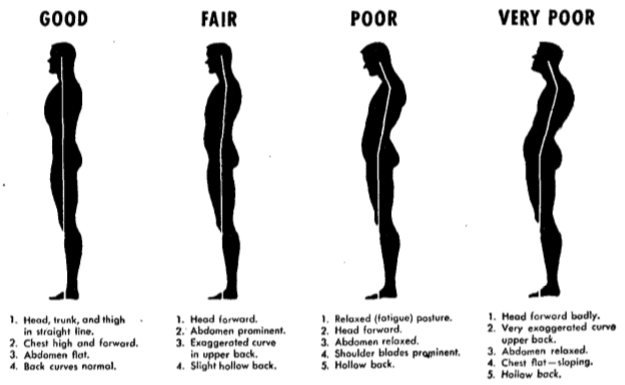 d. Posture judgments help to motivate the men. The four posture silhouettes above are highly valid standards by which to make such judgments. It takes a few minutes to judge 100 men, especially if they are inspected in small groups. They should also be judged occasionally when off guard. Announcing the platoon with the best average posture may stimulate friendly rivalry.
d. Posture judgments help to motivate the men. The four posture silhouettes above are highly valid standards by which to make such judgments. It takes a few minutes to judge 100 men, especially if they are inspected in small groups. They should also be judged occasionally when off guard. Announcing the platoon with the best average posture may stimulate friendly rivalry.POSTURAL EXERCISES
GENERAL. The ten exercises below are designed to develop the postural muscles. All of these exercises have SLOW CADENCE and two-count movements. They are especially valuable for use in the “strength course.”EXERCISE 1
 Starting Position. Attention.
Starting Position. Attention.
Movement:(1) Swing arms forward and upward to full stretch overhead and at the same time rise high on toes.(2) Swing arms sideward and downward slowly and press back hard. At the same time retract chin and let heels drop to the ground. Avoid an exaggerated arch in lower back.EXERCISE 2
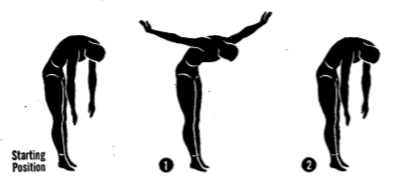 Starting Position. Trunk leaning forward about 60°, arms hanging downward loosely from shoulders.
Starting Position. Trunk leaning forward about 60°, arms hanging downward loosely from shoulders.
Movement:(1) Swing arms sideward and backward vigorously, retracting chin forcefully and flattening upper back. Hold this position momentarily.(2) Recover to starting position.EXERCISE 3
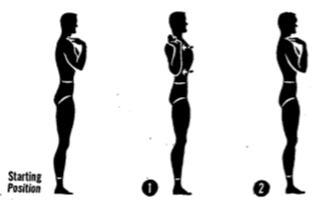 Starting Position. Standing, fingertips touching shoulders, arms in front of chest, and elbows downward.
Starting Position. Standing, fingertips touching shoulders, arms in front of chest, and elbows downward.
Movement:(1) Move upper arms outward and backward, with elbows hugging sides. Hold the position a full second while trying to force arms further around and back. At same time, retract head and attempt to stretch upward.(2) Recover to starting position.EXERCISE 4
 Starting Position. Kneeling on the mat, trunk bent sharply forward, hands behind head.
Starting Position. Kneeling on the mat, trunk bent sharply forward, hands behind head.
Movement:(1) Still leaning forward, straighten upper back and press elbows and head backward. At the same time pull in chin.(2) Recover to starting position.EXERCISE 5
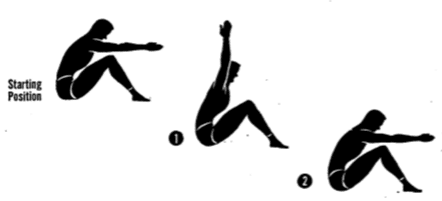 Starting Position. Sitting on the floor, knees raised, trunk bent forward, and arms stretched forward.
Starting Position. Sitting on the floor, knees raised, trunk bent forward, and arms stretched forward.
Movement:(1) Still leaning forward, swing arms upward and backward. At the same time pull in chin.(2) Recover to starting position.EXERCISE 6
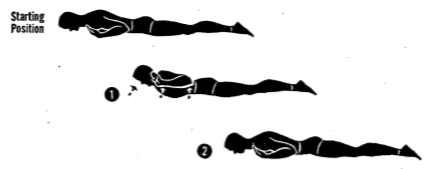 Starting Position. Lying face down on the floor, with elbows at sides and fingertips on shoulders.
Starting Position. Lying face down on the floor, with elbows at sides and fingertips on shoulders.
Movement:(1) Rotate arms outward and pull elbows in hard to sides. At the same time pull in chin and lift head about 6 inches from the floor. Hold this position a full second.(2) Recover to starting position.EXERCISE 7
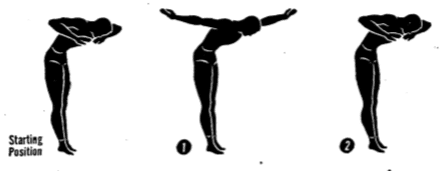 Starting Position. Bending forward about 45°, elbows horizontally sideward from shoulders, forearms bent forward, palms down, thumbs just in front of shoulders.
Starting Position. Bending forward about 45°, elbows horizontally sideward from shoulders, forearms bent forward, palms down, thumbs just in front of shoulders.
Movement:(1) Straighten elbows and swing arms slowly but hard sideward and backward. At the same time retract head.(2) Recover to starting position.EXERCISE 8
 Starting Position. Leaning slightly forward, elbows bent, and fingertips touching shoulders.
Starting Position. Leaning slightly forward, elbows bent, and fingertips touching shoulders.
Movement:(1) Make small circles about a foot in diameter, elbows circling upward and backward. Press arms backward and retract head. Movement is slow.
(2) After completing sufficient repetitions, recover to starting position.EXERCISE 9
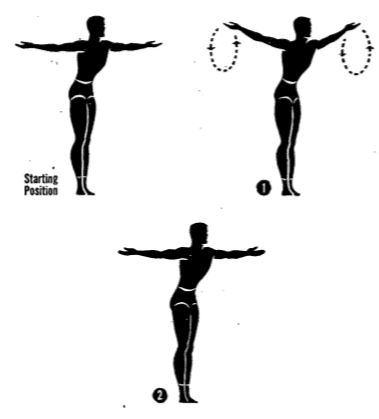 Starting Position. Leaning slightly forward, arms horizontally at sides, palms up.
Starting Position. Leaning slightly forward, arms horizontally at sides, palms up.
Movement:(1) Make small circles about a foot in diameter, hands circling upward and backward. Press arms backward and retract head. Movement is slow.(2) After completing sufficient repetitions, recover to starting position.EXERCISE 10
 Starting Position. Arms overhead.
Starting Position. Arms overhead.
Movement:(1) Pull arms slowly downward until fists are beside shoulders. Pull as though chinning.(2) Recover to starting position.
- Strength training
- Pull-ups-Leg Raises: do as many you can (try to improve by 1 more each week) rest 20 sec. then use bar to do leg raises try to touch toes to bar 5 times increasing 1 each week.
- War club. This apparatus is a dub with a handle. It should weigh about 20 pounds. It may be made from a fruit can filled with concrete and a handle of any convenient wood.
- Situps: Do as many as possible.
- Grip: 8 Exercises for Incredible Strength!
- Jump squats:
- Barbell curls
- Military Press
- Barbell snatch
- 20 minute jog after.
- 5 minutes of stretches for cool down
- Early Morning--Pray the Eucharistic Stations of the Cross
- Today's exercise: Cardio Intervals (68 mins)
- 20 minutes jog
- 5 sets 1 min. intervals (1 min fast-1 min rest)
- 5 min. walk
- 3 sets 3 min. intervals (3 min fast-3 min rest)
- 20 minutes walk
- Afternoon--20 minutes sit before the Blessed Sacrament
Fridays Plan
- Early Morning--Pray the Sorrowful Mystery of the Rosary or the Chaplet of the Holy Face
- Today's exercise: Your choice 30 minutes of stretching or whole body calesthetics workout
Follow the videos below for routines to warm up your entire body before the workout. For more tips on mobility and stretching, follow Onnit’s Durability Coach, Cristian Plascencia, on Instagram (@cristian_thedurableathlete).
Workout #1:
- Beginner Calisthenics Circuit Workout Do all the exercises in the order shown, resting 30 seconds between exercises and 3 minutes afterward. Repeat for 3 rounds.
- 1. 10 pullups Do these with your palms facing away from you, hands just outside shoulder-width apart.
- 2. 10 chinups Palms face toward you, hands shoulder-width apart.
- 3. 20 dips Use parallel bars and lower your body until your upper arms are parallel to the floor.
- 6. 50 crunches Curl your torso up until your shoulder blades are off the floor.
- 7. 10 burpees Stand with feet shoulder width and squat down to place your hands on the floor. Now shoot your legs behind you fast so you end up in the top position of a pushup. Jump your legs back up so they land between your hands and then stand up quickly.
- 8. 30 seconds jumping rope
Rest 5 seconds between exercises and 8 minutes at the end of one round. Repeat for 2 rounds.
- 1. 5 muscle ups Hang from a pullup bar with hands outside shoulder width and legs straight. Draw your shoulder blades back and together and arch your back to swing your body forward a bit. Then quickly try to bring your shoulders and hips together so that your body swings back and rises up until your hips touch the bar. Press your body straight up over the bar to lock out your elbows.
- 2. 50 pushups
- 3. 25 jump squats
- 4. 15 burpees
- 5. 15 pullups
- 6. 60 seconds leg flutters
- Lie on your back on the floor and tuck your tailbone to flatten your lower back into the floor. Brace your core. Extend your legs overhead and then lower them as far as you can before you feel your lower back is about to buckle up from the floor. Begin raising and lowering both legs, alternately, a few inches (as if swimming). Keep your core braced so your lower back stays against the floor.
- 7. 10 pullups
- 8. 30-second sprint, nonstop-Run up a hill if you can, or run in place.
Workout #3: Advanced Calisthenics Circuit Routine
Perform each exercise for 30 seconds straight. Do NOT rest between exercises. Complete 1 round.
- 1. Hold a handstand for 30 seconds
- You can do the handstand using a wall for support. Place your hands about six inches back from the wall and get into a downward dog pose. Step one foot toward the wall and then kick your back leg up while focusing your eyes on the floor in front of you. Press into your hands and straighten your body with your heels against the wall.
- 2. Jump squats
- 3. Wall push ups
- Get into pushup position in front of a wall and walk your feet up the wall behind you. Press your feet into the wall to create tension throughout your body, and perform pushups.
- 4. Kick up push ups
- Sit on the floor and roll backward, as if doing a reverse somersault. Stop when your feet face the ceiling and reverse the direction quickly, performing a kickup—kick your feet up and forward so you launch off the floor and land in a deep squat. From there, drop into a pushup.
- 5. Squat position move side to side
- Get into a low squat and step side to side. Take two steps one direction and then switch directions.
- 6. X’s and O’s core workout
- Lie on your back on the floor and extend your arms and legs to form an X-shape. Crunch and draw your knees to your chest, hugging them with your arms
- 7. Dips
- 8. Jumping lunges
- Get into a lunge position—rear knee just above the floor and front knee bent 90 degrees. Jump and switch legs in mid air, landing with the opposite leg forward.
- 9. Hops-Hop side to side, staying on the balls of your feet.
- 10. Pullups
Workout #4: Extreme Athlete Calisthenics Circuit Routine
Rest 30 seconds between exercises but do not rest between rounds. Do 3 rounds.
- 1. 10-second back lever hold
- Grasp a bar with hands outside shoulder width and curl your knees up to pass underneath the bar and over your head. Extend your legs so your body is now inverted. Bend your knees 90 degrees and slowly lower your body until you’re parallel to the floor. See this video for more.
- 2. 7-second flag hold
- You’ll need a ladder or other object with rungs. Push onto one rung with your stronger arm and pull on a higher rung with your weaker arm and raise your legs up off the floor until your body is parallel to the floor.
- 3. 5-second front lever hold
- Pull your body up and extend your torso back so you are parallel to the floor.
- 4. 15-second bent arm planche hold
- Suspend yourself over dip bars and extend your legs behind you with your arms straight so that your body is parallel to the floor. See this video for more.
- 5. 30-second handstand hold
- Hold the top position of a handstand (arms extended).
- 6. 3 very slow muscle ups
- Take at least 3 seconds to press your body up from the bar.
- 7. 10 slow dips
- Take at least 3 seconds to lower your body.
- 8. Pull up hold position for 30 seconds
- Hold the bottom of a pushup (chest just above the floor).
See many of these exercises in action in the video below.
Sample Video Workout:
Not only are you going to love the results from these workouts, you are going to find out they’re fun to try too. Good luck!
Saturdays Plan
- Early Morning--Reflect on your week in silence for 15 minutes-What you have done well; not so well and concerns that need to be addressed: Do a litany of hours with Mary.
- Do 1 to 3 hours of walking, golf, swimming. Try hiking using my Divine Mercy Hikes as a guide.
- Around noon do the roman plan based on the spa day of ancient Rome or a Mikvah .
- Afterward examine your conscious being as completely honest with yourself and God then go to confession.
- Oil the body
- Light exercise
- Warm bath/massage
- Steam Room/drinks
- Hot bath/sauna
- cold bath
- massage with oils
- entertainment/sunbath
- stroll: look at art
- Food/drinks
Jewish Purity[3]Mikvah
- · Immersion in the mikvah has offered a gateway to purity ever since the creation of man. The Midrash relates that after being banished from Eden, Adam sat in a river that flowed from the garden. This was an integral part of his teshuvah (repentance) process, of his attempt at return to his original perfection.
- · Before the revelation at Sinai, all Jews were commanded to immerse themselves in preparation for coming face to face with G‑d.
- · In the desert, the famed “well of Miriam” served as a mikvah. And Aaron and his sons’ induction into the priesthood was marked by immersion in the mikvah.
- · In Temple times, the priests as well as each Jew who wished entry into the House of G‑d had first to immerse in a mikvah.
- · the function of mikvah is not to enhance physical hygiene. The concept of mikvah is rooted in the spiritual.
- · Jewish life is marked by the notion of Havdalah: separation and distinction. On Saturday night, as Shabbat departs and the new week begins, Jews are reminded of the borders that delineate every aspect of life. Over a cup of sanctified wine, the Jew blesses G‑d who “separates between the holy and the mundane, between light and darkness, between Israel and the nations, between the seventh day and six days of labor ... . ”
- · In fact, the literal definition of the Hebrew word kodesh—most often translated as “holy”—is that which is separated; segregated from the rest for a unique purpose, for consecration.
- · In many ways, mikvah is the threshold separating the unholy from the holy, but it is even more. Simply put, immersion in a mikvah signals a change in status—more correctly, an elevation in status. Its unparalleled function lies in its power of transformation, its ability to effect metamorphosis.
- · The mikvah personifies both the womb and the grave; the portals to life and afterlife. In both, the person is stripped of all power and prowess. In both, there is a mode of total reliance, complete abdication of control. Immersion in the mikvah can be understood as a symbolic act of self-abnegation, the conscious suspension of the self as an autonomous force. In so doing, the immersing Jew signals a desire to achieve oneness with the source of all life, to return to a primeval unity with G‑d. Immersion indicates the abandonment of one form of existence to embrace one infinitely higher. In keeping with this theme, immersion in the mikvah is described not only in terms of purification, revitalization and rejuvenation, but also, and perhaps primarily, as rebirth.








No comments:
Post a Comment